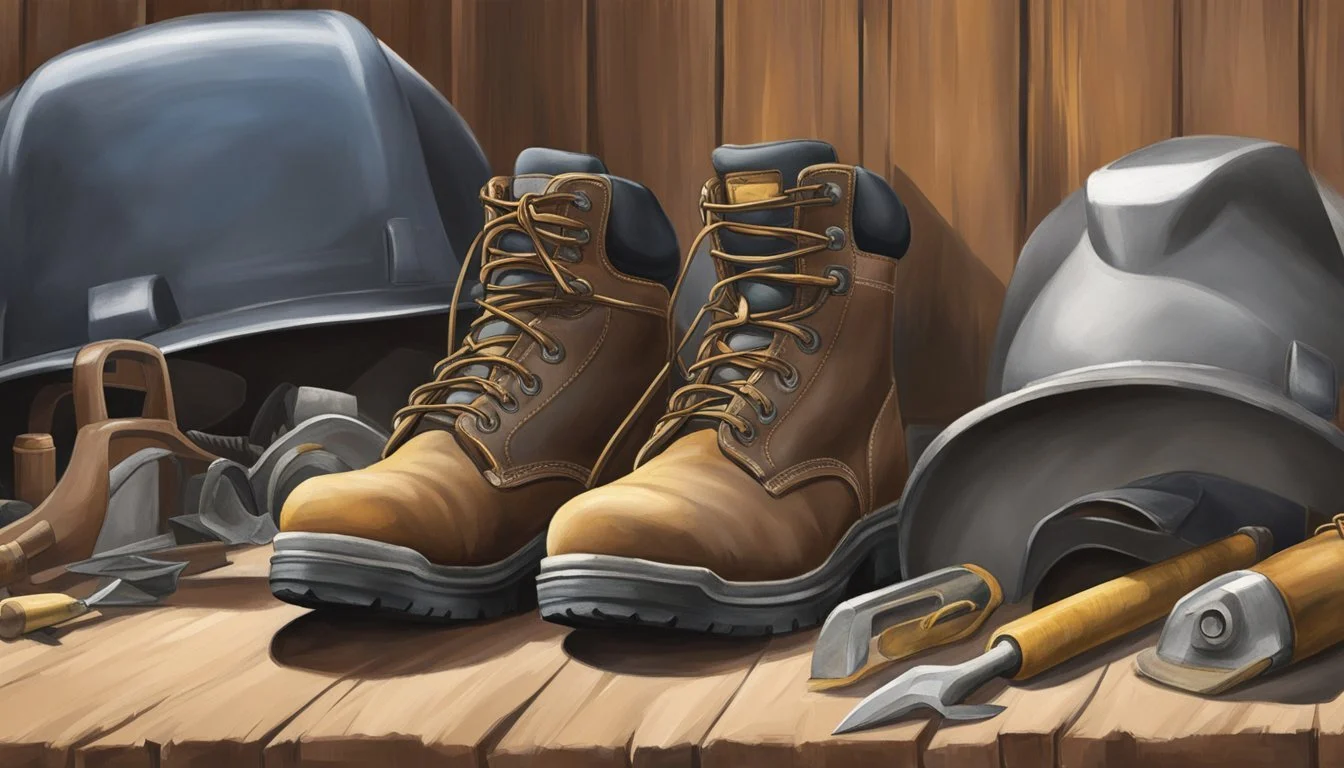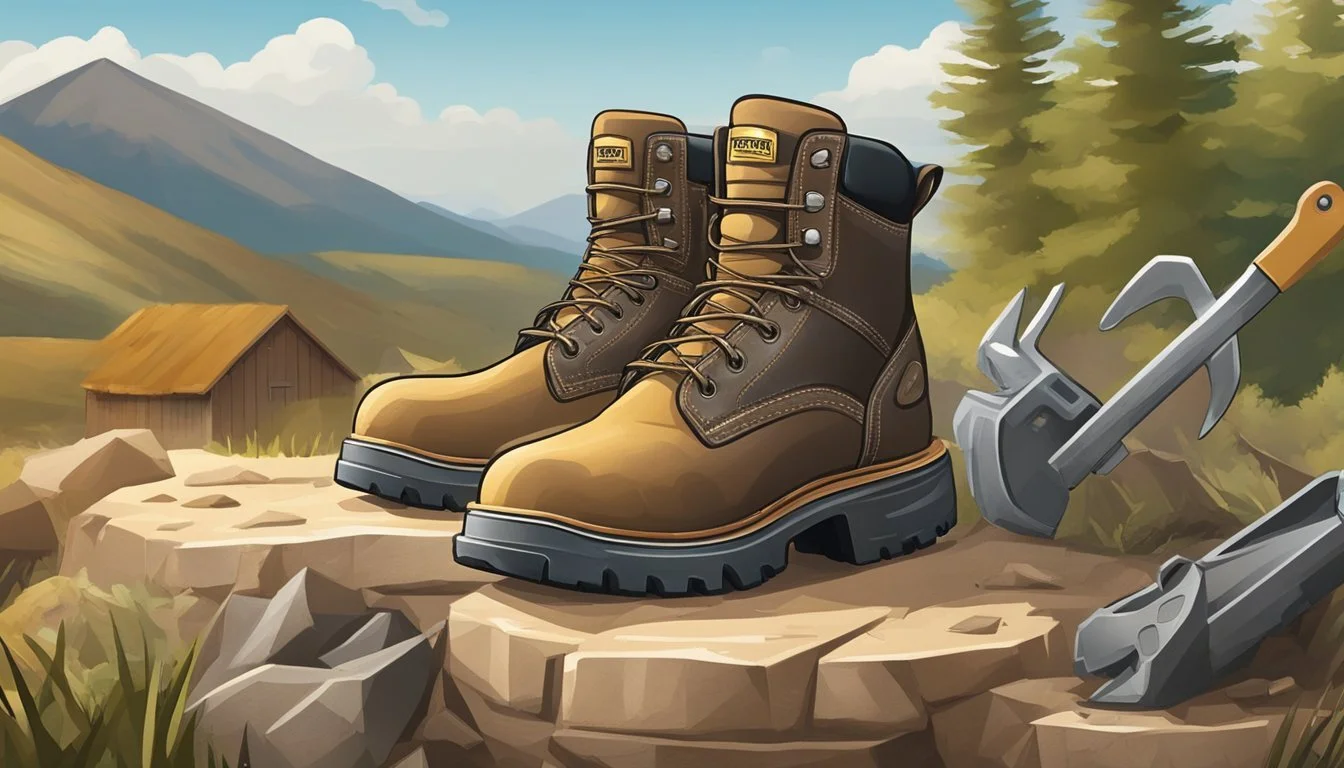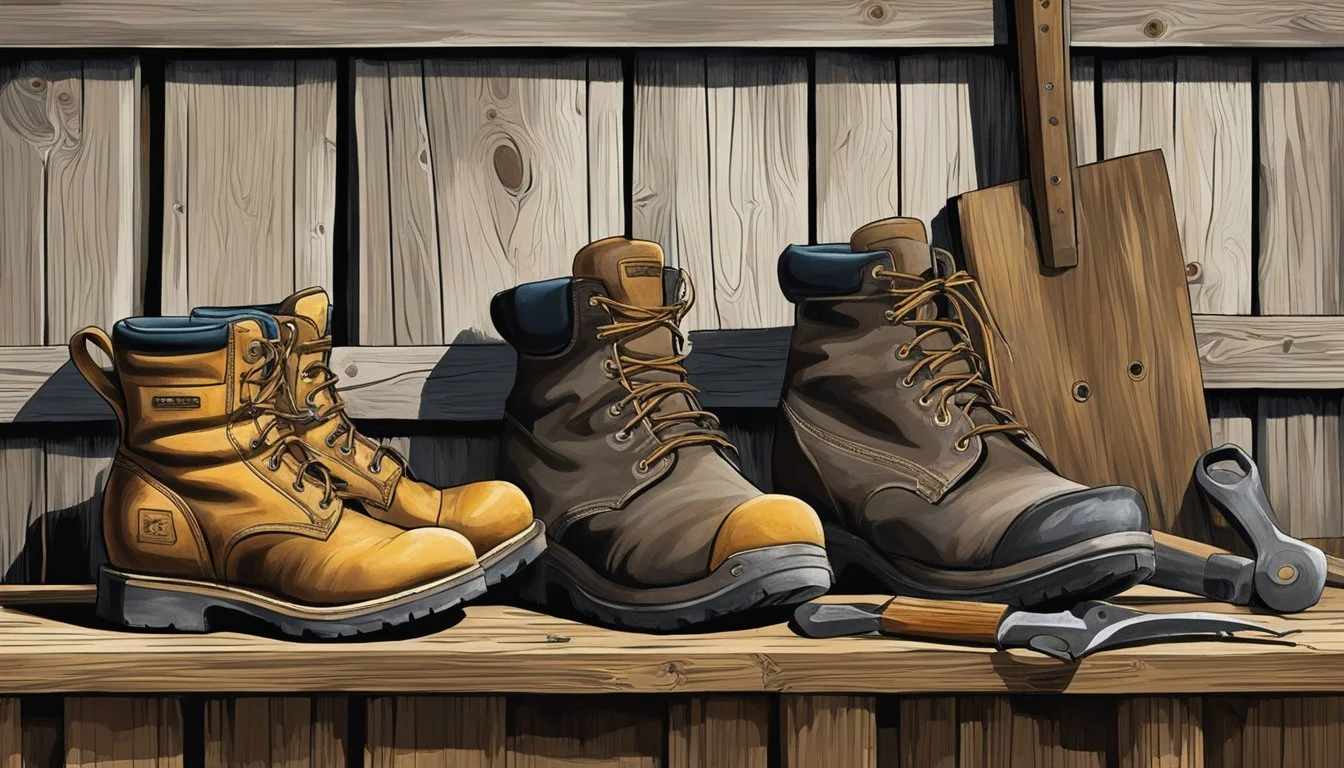The Best Work Boots for Ultimate Protection and Comfort on the Homestead
A Practical Guide for Rural Living
For those who manage a homestead, the demands of daily tasks require footwear that offers both protection and comfort. Selecting the best work boots is not merely a matter of personal preference, but a vital decision impacting one's safety and efficiency while working. With an array of options on the market, from safety-toe to soft-toe boots, it's essential to find a pair that can withstand the rigors of outdoor labor while also providing the necessary support for long hours on your feet.
The industry has acknowledged the unique needs of homesteaders, crafting boots that cater to various conditions, such as waterproofing for wet environments and carbon or steel toes for injury prevention. High-quality work boots, such as the KEEN Utility Chicago 6-Inch Waterproof with Carbon Toe, offer a blend of durability and protective features without compromising on comfort. Meanwhile, designs like the Thorogood American Heritage 6-Inch Moc Toe focus on providing support and a comfortable fit, which is crucial for those spending the majority of the day outdoors.
In addition to safety and comfort, advanced materials and innovative design are at the forefront, with boots that facilitate better breathability and are made with lightweight materials to reduce fatigue. Brands have also included ergonomic features that cater to diverse foot shapes and work conditions, ensuring that the wearer's comfort is not an afterthought. The choice of the best work boot is thus a careful balance between the technical features that ensure safety and the comfort considerations that make day-long wear possible.
Essential Features of Work Boots
Work boots are critical for safety and comfort in challenging environments. The following features are vital in choosing boots that will withstand the rigors of homestead duties while providing protection and comfort.
Materials and Durability
Full-grain leather is renowned for its durability, making it a top choice for work boots. Boots crafted from this high-quality material are more likely to endure the wear and tear of tough jobs. Durability is also dependent on construction quality, with Goodyear welt construction being particularly robust.
Protection Standards
A key feature is the safety toe, with options like steel toe caps providing the highest level of protection against compression and falling objects. Some boots may use composite materials for a lighter alternative that still meets safety standards.
Comfort and Fit
Comfort in work boots comes from features like padded or cushioned insoles and adequate arch support. Proper fit is crucial and technologies like 4LR (Four Layer Rebound) ensure stability and comfort. Comfortable work boots should provide a snug fit without constricting the foot.
Slip Resistance and Traction
Boots with slip-resistant outsoles and good outsole grip are essential for maintaining footing on slick surfaces. Many designs feature oil and slip-resistant outsoles to enhance safety in various working conditions.
Insulation and Weatherproofing
In colder climates, insulation is a must. Look for boots with thermal linings to keep feet warm. Waterproof work boots with a moisture-wicking lining help keep feet dry in wet conditions, making them ideal for both wet and winter environments.
Design and Style Variations
Boots come in different styles, such as the moc toe boot or the wedge sole design, catering to personal preferences and specific job requirements. While the steel toe boot is a classic, soft toe boots might be sufficient for jobs without risk of impact injuries.
Selecting the Right Work Boots
Selecting the right work boots is crucial for protection and comfort, especially for those involved in manual labor on the homestead. The right pair blends utility, safety, and comfort to meet the demands of any task.
Boot Types and Their Uses
Different types of work boots cater to various industrial needs. Steel toe work boots are essential for high-risk areas like construction sites, providing maximum protection against heavy falling objects. For environments with a lower risk of impact injuries where safety toe is not a mandate, soft-toe work boots offer a more lightweight and comfortable experience. These may often feature mesh linings for breathability and cushioned insoles for additional comfort.
Customization and Personal Preferences
Personal preferences play a significant role in boot selection. Customization options for work boots can include choices in material, such as leather or synthetic, and special features like waterproofing, insulation, or electrical hazard certification. One should consider boots with a comfortable midsole and ample arch support suited to their foot type to ensure comfort throughout the workday.
Sizing and Proper Fit
Ensuring a proper fit is vital for both comfort and safety. Boots should have a snug fit without being too tight – they shouldn't rub or pinch anywhere. Leave enough room to wiggle toes freely and ensure the heel does not slip. It's often recommended to try on boots with the kind of socks you'll wear during work to achieve the best fit.
Boot Size: 7, Foot Length (inches): 9.625
Boot Size: 8, Foot Length (inches): 9.938
Boot Size: 9, Foot Length (inches): 10.25
Boot Size: 10, Foot Length (inches): 10.563
Budget Considerations
Quality work boots are an investment in personal safety and long-term comfort. However, there are budget-friendly options such as the Caterpillar Men's Second Shift Work Boots that do not compromise on essential features. It's important to balance cost with quality, ensuring that one does not sacrifice safety or long-term durability for short-term savings. Remember that higher-priced boots often come with better construction and materials leading to increased longevity and better overall value.
Safety and Compliance
When selecting work boots for the homestead, it's essential to consider the safety features and compliance with regulatory standards that ensure protection from common hazards.
Regulatory Standards and Certifications
Work boots should meet specific regulatory standards and certifications to ensure they provide adequate protection. Look for boots that adhere to the American Society for Testing and Materials (ASTM) standards, which include ASTM F2413 for foot protection. Safety-toe boots often come with certifications such as the ASTM F2413-18, which covers steel toe cap and other safety-toe options like composite materials. Additionally, for those working with electricity, boots that offer electrical hazard protection are certified under ASTM F2413-05, ensuring electrical resistance and safety in environments where electrical hazards are present.
Certification: ASTM F2413-18
Description: Standard for Toe Protection Footwear
Relevant Safety Features: Safety toe (Steel/Composite)
Certification: ASTM F2413-05
Description: Standard for Electrical Hazard Protection
Relevant Safety Features: Electrical hazard safe
Hazard-Specific Features
When homesteaders consider hazard-specific features in work boots, they seek attributes tailored to handle particular risks. For protection against falling objects, a safety-toe with a steel toe cap or equivalent is critical. For those who need heavy-duty traction, look for boots with outsoles designed for maximum grip to prevent slips and falls. For electrical hazard protection, features that provide electrical resistance such as non-conductive materials and shock-absorbing soles are essential to reduce the risk of electrical shocks.
Safety-toe: Guard against impact or compression
Traction: Prevent slips and falls with high-quality outsoles
Electrical Hazard Safe: Minimize risk of electric shock
Selecting work boots with these specific features ensures a high level of safety and compliance with industry standards, enabling workers to be protected from the various hazards of homestead work.
Advanced Work Boot Features
The modern homesteader requires work boots with precise technological enhancements and attributes tailored to various professional demands. This level of specificity in work boot features ensures longevity, comfort, and function.
Innovative Technologies
Work boots now incorporate advanced materials and technologies aimed at increasing comfort and durability. KEEN Utility boots, for example, integrate metal-free construction with carbon toes, offering lightweight protection. Technologies such as MaxWear wedge soles and shock-absorbing features provide stability and rebound, which are imperative for long workdays.
Specialty Boots for Different Professions
Each profession has its unique challenges, necessitating boots with specific features. For instance, electricians may require boots with non-conductive soles for safety, while construction workers could benefit from a waterproof membrane and a durable nubuck upper. Thorogood's 1957 Series Waterproof Steel Toe Work Boots are crafted with these requirements in mind, ensuring the right boot for the right job.
Brands and Their Legacy
Several brands have built a legacy on their ability to offer quality work boots that address the nuanced needs of hardworking individuals. Thorogood maintains a reputation through its American Heritage line, which combines tradition with innovation. The Brunt Marin offers a versatile option for those in need of robust yet affordable footwear, highlighting how brand history often guides present-day functionality.
Utility Beyond the Work Site
Modern work boots serve a dual purpose; they provide safety on the job and versatility off it. Many are designed to transition smoothly from a work environment to casual settings. With reinforced construction and aesthetically pleasing designs, work boots like the KEEN Utility Chicago 6-Inch Waterproof blend utility and style, proving functional for diverse activities beyond professional usage.
Maintenance and Longevity
Proper maintenance not only ensures that work boots remain protective and comfortable but also maximizes their longevity. By regularly attending to cleaning, repairs, and preventive care, owners can safeguard the quality of materials such as leather and nylon and maintain key features of the boots like Goodyear welt construction and cushioned insoles.
Cleaning and Care
Leather Boots:
Remove dirt with a soft brush.
Apply a cleaner specific to leather types (full-grain, nubuck) and wipe with a damp cloth.
Condition leather to maintain suppleness and avoid cracks.
Polish if necessary to preserve the leather's finish.
Nylon and Other Materials:
Wash gently with mild soap and warm water.
Air dry away from direct heat or sunlight to prevent material degradation.
Consistent care prevents buildup of odor-causing bacteria and maintains the boot's overall structure including adequate arch support.
Repair and Replacement
Sole and Heel Wear:
Inspect soles for significant wear; replace if traction is compromised.
Heels may also require replacement, a sign can be uneven wearing on one side.
Uppers and Stitching:
Regularly check for loose threads or tears.
Seek professional repair for issues with Goodyear welt construction to ensure water resistance and boot integrity.
Prompt repair extends the durability and functionality of safety-toe and soft-toe work boots alike.
Maximizing Boot Life
Rotate boots if possible to allow them to air out and rest between uses.
Utilize cedar shoe trees to retain shape and absorb moisture.
Store in a cool, dry place to prevent material decay and extend boot life.
Apply waterproofing treatments periodically, especially for boots exposed to harsh environmental conditions.
Adhering to these maintenance steps ensures the longevity of the work boots while maintaining their comfort and protective qualities.
Additional Considerations
When selecting the best work boots for homestead use, potential buyers should pay close attention to sustainability practices, purchasing options, and customer insights, which can significantly influence the overall satisfaction with the product.
Environmental Impact and Sustainability
Consumers increasingly prioritize environmental impact and sustainability in their purchasing decisions. Work boots made with eco-friendly materials and ethical craftsmanship not only lessen environmental footprints but often align with superior quality and comfort. Brands that innovate with biodegradable components and have transparent sustainable production processes are setting new standards in the industry.
Online Purchase vs. In-Store
The debate between purchasing work boots online versus in-store hinges on convenience and fit accuracy. While online retailers like Amazon offer a broad range of options and often competitive pricing, physical stores provide the advantage of trying on boots for immediate comfort and fit assessment. Buyers should consider whether the vendor provides detailed sizing guides and free returns to mitigate fit issues when purchasing online.
Testimonials and User Reviews
Customer feedback is invaluable for gauging the real-world performance of work boots. Testimonials often highlight aspects like comfort, safety features, and durability—key factors for protection and comfort on the homestead. Prospective buyers should seek out boots with positive user reviews that consistently mention comfort and confirm the effectiveness of safety innovations. A product with many testimonials attesting to its comfort and craftsmanship is one that stands up to the rigors of daily use.
Conclusion
Selecting the best work boots is essential for safety and comfort on the homestead. The mentioned picks have established themselves as leaders in the industry:
KEEN Utility Chicago and Brunt models have set the standard for safety-toe work boots.
For those favoring soft-toe options, Thorogood American Heritage offers a balance of comfort and durability.
Helly Hansen’s Magni Winter Boots provide exceptional insulation, suited for cold weather conditions, featuring a composite toe cap.
Timberland Pro Pit Boss boots come with a reputation for quality and meet rigorous safety standards.
Comfort meets functionality in boots like Keen Utility Cincinnati, which cater to demanding work environments.
Before purchasing, individuals should assess their specific needs, considering factors such as toe protection, weather resistance, and support. It's worth noting that innovations like the BOA® Fit System in some Helly Hansen models allow for quick adjustments, a practical feature for various work scenarios. For convenience, Ariat Hybrid Venttek offers pull-on access without sacrificing protection. Both the Keen Utility San Jose Oxford and Nick’s Handmade Boots exemplify lightweight and custom craftsmanship, respectively.
Ultimately, the right pair of work boots enhances productivity and ensures the wearer's well-being, allowing them to focus on the tasks at hand with assured footing.







